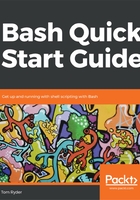
Getting help with Bash
Sometimes in technical books, people skip the Getting help heading. Don't skip this one! It's very important, and will save you a lot of time and confusion.
You can get help on using most of the commands in this book with a two-step process. When you're using Bash, to get help on a command named printf, use help first:
bash$ help printf
You'll get some help output, so you now know that printf is a Bash keyword or builtin. That's the version of the command you want help with, because that's the one that you'll be using when you call it from within Bash.
To see why this is confusing, try the man manual reader command, instead:
bash$ man printf
You'll get a completely different document, a full manual page! The features aren't even the same! What's going on?
In a shell script, the same command can have more than one implementation. In Bash, you can see a list of all of them using the type command with its -a (all) switch:
bash$ type -a printf printf is a shell builtin printf is /usr/bin/printf
Notice how there are two results for printf: the first is a shell builtin – a part of Bash itself – and the second is a program on your filesystem. They will behave differently and have different documentation. We'll see more of the type command in later chapters.
So remember: always try help first! Some people use Bash for many years before learning it exists, and wonder why the man pages are always wrong. You can see a full list of available help topics by typing it on its own, with no arguments:
bash$ help